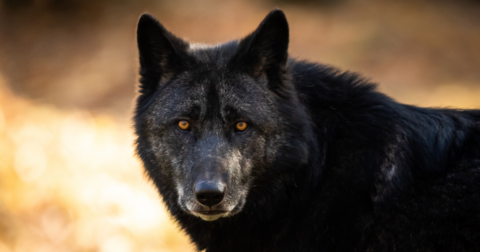Southwest Wisconsin Dairy Operation Linked to Spill Affecting Eight Miles of Trout Waters
Climate•4 min read
Reported
The livestock industry wants to control wolf predators by hunting them, but science suggests the tactic doesn’t pan out.


Words by Jack McGovan
Sometime after midnight in the fall of 2022, a pony named Dolly was savaged by a wolf in a small village in Germany. The story might have ended there, just as it did for the more than 4,000 livestock animals killed by wolves that year in the country. But Dolly belonged to Ursula von der Leyen, president of the European Commission. After her pony’s untimely demise, von der Leyen added the wolf to a kill list, and called for a loosening of protections against wolf hunting, pushing for it as a way to protect farm animals like Dolly. But even though wolves kill some cows and sheep, does a strategy of hunting more wolves actually work to control them? Some research suggests no, but ranchers and farming groups continue to push for more latitude to hunt these predators.
The push to loosen hunting restrictions on wolves isn’t just happening in Europe. The debate is also playing out in a number of U.S. states. In Colorado, the livestock industry opposed wolf reintroductions, but a lawsuit for a temporary restraining order was rejected by the courts in mid-December. Days later, Colorado officials released five wolves in Grand County.
When livestock are killed by wolves, it’s a painful death — farm animals have no means for protecting themselves. There are economic losses too, which can hit small scale farmers with few livestock harder than others. Researchers have found hunters and farmers have had negative attitudes towards wolves for decades.
To address the conflict, hunting and farming groups have for years pushed for relaxing legal restrictions on hunting to make it easier, or legal, to kill predator wolves. At first glance, it does seem to be an effective strategy.
In 2021, Idaho lawmakers passed a law allowing 90 percent of the state’s 1500 wolves to be killed, which, according to the USDA wildlife services, reduced the number of attacks in 2023 when compared with the previous two years.
“Killing wolves seems like the easiest way to solve the conflict with livestock,” says Miroslav Kutal, a forest ecologist at the University of Mendel, Czech Republic, with decades of experience in carnivore conservation. But it’s not actually very effective, unless you eradicate all wolves in a given area, which is not something Kutal supports.
The year of the law’s passage in Idaho for example, there were 187 investigations of farm animals killed, allegedly by wolves. In 2022 and 2023, the number of suspected wolf killings did decrease — 157 and 142, respectively. But that relatively modest decrease was only achieved by killing 1000 wolves in just two years — which works out to roughly 26 wolves killed per each avoided attack. Plus, not every investigation determines wolves were actually the culprit.
Killing wolves also has consequences beyond the livestock industry. “Predators are performing some ecological roles in ecosystems, which are not really appreciated,” says Kutal. After wolves were introduced to Yellowstone Park and its surrounding areas in 1995, for example, these natural predators stabilized the ecosystem, by keeping the elk population in check.
Kutal’s research suggests we should be skeptical of policies that encourage wolf-hunting. In a study published in November, he and other researchers analyzed wolf-hunting data from 2014-2019 in Slovakia, and found no relationship between the number of wolves killed and livestock losses, one way or the other. Other research from Denmark came to a similar conclusion: the lethal removal of “problem wolves” may be inefficient in practice.
The reason why might be that most wolves aren’t interested in farm animals anyway. “From what we know about habitat preferences of wolves, they try to find places where they can find their wild natural prey,” says Peter Sunde, a professor of wildlife ecology at Aarhus University, and one of the lead authors of the Denmark paper. For wolves, their usual prey are deer and elk. “They also typically prefer to settle in habitats where you have a high coverage of forest.”
Some evidence even suggests that killing wolves can lead to an increase in the number of livestock attacks. Wolf researcher Robert Wielgus studied the impact of Washington state’s policy of killing wolves to protect cattle, and found more cattle were killed, not fewer.
After publishing the data, ranchers complained to state lawmakers, who cut funding for his work. He eventually sued and won — the court awarded $300,000 in damages.
In the case of Dolly, University of Mendel’s Kutal suspects that the dead pony might not be von der Leyen’s real motivation for her crackdown on wolves anyway. Farmers and hunters are very vocal about policies that allow wolf hunting to protect their livestock, and von der Leyen may be using the issue as a way to get agribusiness groups on her side ahead of the upcoming European elections, he says.
In response to Sentient’s request for comment, a spokesperson for the European Commission pointed to the language of the proposed policy, which discusses how wolf populations have increased enough to justify a change in protected status from ‘strictly protected’ to ‘protected.’ Other arguments for a change in policy include economic and emotional consequences for livestock farmers. Still, the bottom line: there is no specific evidence in the document explaining why the Commission chose hunting over other measures for reducing wolf-livestock conflict.
Even research requested by the Commission does not point to hunting as an effective policy. An in-depth analysis on wolves in the EU was carried out on behalf of the Commission and published in December 2023. The authors found “non-targeted culling (i.e., hunting) does not seem to reduce wolf depredations on livestock unless it is carried out with such intensity that it effectively reduces the density of wolves over large areas.” Not only that, but when it came to targeting specific individual wolves, the report found “In Germany… 7 out of the 8 wolves shot for this reason were the wrong individual.”
When asked if that meant the Commission supported significantly reducing wolf populations, the spokesperson tells Sentient that the in-depth analysis does not represent the Commission’s position, and that the “proposal would… create additional flexibility… on how to deal with increased damages and potential socio-economic conflicts associated with the wolf.” The spokesperson added that “the Commission also emphasizes the importance of continued investment in appropriate prevention measures.”
A group of 300 environmental and animal protection organizations, including Greenpeace and the World Wildlife Federation, have criticized the Commission in a joint letter for the “untransparent manner” in which the decision to change the protection status of wolves was made. A survey of rural communities in the EU found that 68 percent supported maintaining strict protection status of large carnivores.
Sunde, an ecologist, has a different take. The problem of wolf-livestock conflict is blown “completely out of proportion,” he says, and there’s data to back this up. Data looking at cattle and sheep losses in Idaho, Wyoming, Montana and Wisconsin in 2015 and 2020, respectively, found that the “percent of livestock killed by wolves never exceeded 0.21% for sheep and 0.05% for cattle” whereas losses due to illness and weather conditions were much higher: 10 percent for sheep, and 3 percent of all cattle.
There are alternatives to hunting wolves that may do a better job of protecting farm animals. One is to rewild grazing land, which gives wolves more natural habitat in which to roam. The Western Watersheds Project has been doing this for decades, starting in the 1970s.
“My personal and professional interest is to lessen livestock grazing to take that pressure off of wolves and off of native wildlife,” says Delaney Rudy, Colorado Director at the Western Watersheds Project. But, she says, there are few farmers left willing to relinquish their livestock permits, and so she supports other coexistence measures.
Kutal says fencing is an option, as is having a dog for protection that can make wolves think twice about attacking.
Other solutions include removing carcasses of livestock who’ve died from other means, or having a human presence on ranches or farms, according to Kaitie Schneider, a representative of Defenders of Wildlife. Something called “fladry” is another option — a wire fence, sometimes electrified, that is adorned with red flags that flap in the wind.
“Fladry, bright lights, loud sounds: wolves don’t like new things like that, and so it helps kind of spook them away,” says Schneider, who works on wolf-livestock coexistence with ranchers. But there are limitations here too, Schneider adds: these tactics only work when they’re new.
Rekindling the herd instinct might be one technique with long term potential, she suggests. To do so, you have to expose the cows to a human presence until they get more comfortable with other animals around, so they don’t react when a wolf appears in the distance. “If the herd doesn’t scatter apart and they stay as a unit, they have a really good chance,” she says.
“I’ve been out on the landscape at five o’clock in the morning at dawn and been in the middle of a cow herd, and watched the wolf kind of walk right through them,” she says. As the cows didn’t react, the wolf walked off and instead went looking for the next easiest target.
Eric Clewis, a senior representative of Defenders of Wildlife, tells a story about a rancher in Montana who changed his mind about coexistence. Originally opposed to any non-lethal methods of dealing with wolves, the rancher became more open to alternatives after working with Clewis over the past few years.
“It’s just a cool story where someone was opposed to the whole wolf restoration and recovery process,” says Clewis. The rancher has now come full circle, he adds. “[He’s] buying his own non-lethal tools at this point.”
The bottom line: the evidence suggests that killing wolves doesn’t seem to be the answer. “Our decisions should be evidence-based,” says Kutal, before adding, “in wolf issues there are a lot of emotions.”